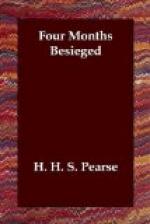The few bluejackets, Gordons, Imperial Light Horse, and Engineers, under Lieutenant Digby-Jones, R.E., were still holding their ground manfully on the extreme westerly crest of Waggon Hill. The Boers were within point-blank range of them on two sides, while beyond the crest and down into Bester’s Valley hundreds of others were waiting for the first sign of panic among our men to rush the position, but held in check by a company of the 60th Rifles and a few Light Horse occupying a small sangar on that side. The ridge, however, was being shelled by the enemy’s guns from Middle Hill and Blaauwbank with such accuracy that many of our men were wounded by that fire, but not a Boer was hit, though the fighting lines were less than 100 yards apart. The 21st Battery Field Artillery, out in comparatively open ground beyond Range Post, swept with shrapnel the slopes and kloofs of Mounted Infantry Hill on one side, and Major Goulburn’s battery, the 42nd, searched the reverse slope of that knoll, smiting the head of a movement by which our foes tried to strengthen their attack. The Natal artillery had done similar service at an earlier stage against another body, and though under heavy rifle fire they still stuck to their guns manfully. Our naval 12-pounder mounted near this battery, but having double the range, played upon Middle Hill, trying by rapid and accurate fire to silence the big Creusot gun there, or baffle its aim.




